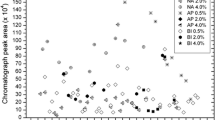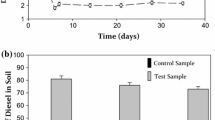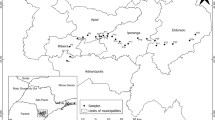Abstract
In this paper, the effect of nitrogen addition on the aerobic bioremediation of a diesel-contaminated soil was studied. Soil was artificially contaminated with diesel at an initial 2% concentration (on a dry soil basis). Nitrogen was added as NH4Cl in a single load at the start of the experiment at concentration levels of 0, 100, 250, 500, 1,000, and 2,000 mg N/dry kg soil, and uncontaminated and unamended soil O2 consumptions were studied. Diesel degradation was indirectly studied via measurements of O2 consumption and CO2 production, using manometric respirometers. Results showed that the 250 mg N/dry kg concentration resulted in the highest O2 consumption among all runs, whereas O2 consumption was reduced by N additions greater than 500 mg N/dry kg. Zero to 0.6 order degradation kinetics appeared to prevail, as was calculated via the oxygen consumption rates. A theoretical biochemical reaction for diesel degradation was developed, based on measurement of the final diesel concentration in one of the runs. According to the stoichiometry, the optimal N requirements to allow complete diesel degradation should be approximately 0.15 g N/g diesel degraded or 1,400 mg N/dry kg of soil, based on the initial diesel concentration used in this study. This implies that N should be added in incremental loads.



Similar content being viewed by others
References
Aislabie, J., Saul, D. J., & Foght, J. M. (2006). Bioremediation of hydrocarbon-contaminated Polar soils. Extremophiles, 10, 171–179.
Aspray, T., Gluszek, A., & Carvalho, D. (2008). Effect of nitrogen amendment on respiration and respiratory quotient (RQ) in three hydrocarbon contaminated soils of different type. Chemosphere, 72, 947–951.
Atlas, R. M. (1991). Microbial hydrocarbon degradation—bioremediation of oil spills. Journal of Chemical Technology and Biotechnology, 52, 149–156.
Bartha, R. (1986). Biotechnology of petroleum pollutant biodegradation. Microbial Ecology, 12, 155–172.
Brook, T. R., Stiver, W. H., & Zytner, R. G. (2001). Biodegradation of diesel fuel in soil under various nitrogen addition regimes. Soil & Sediment Contamination, 10, 539–553.
Chapra, S. C. (1997). Surface water-quality modeling (pp. 29–31). New York: McGraw-Hill.
Coles, C. A., Patel, T. R., Akinnola, A. P., & Helleur, R. J. (2009). Influence of bulking agents, fertilizers and bacteria on the removal of diesel from Newfoundland soil. Soil & Sediment Contamination, 18, 383–396.
Dibble, J. T., & Bartha, R. (1979). Effect of environmental parameters on the biodegradation of oil sludge. Applied and Environmental Microbiology, 37, 729–739.
Gallego, J. L. R., Loredo, J., Llamas, J. F., Vazquez, F., & Sanchez, J. (2001). Bioremediation of diesel-contaminated soils: Evaluation of potential in situ techniques by study of bacterial degradation. Biodegradation, 12, 325–335.
Gea, M. T., Barrena, R., Artola, A., & Sánchez, A. (2004). Monitoring the biological activity of the composting process: Oxygen uptake rate (OUR), respirometric index (RI) and respiratory quotient (RQ). Biotechnology and Bioengineering, 88, 520–527.
Geerdink, M. J., van Loosdrecht, M. C. M., & Luyden, K Ch A M. (1996). Biodegradability of diesel oil. Biodegradation, 7, 73–81.
Jin, S., & Fallgren, P. H. (2007). Site-specific limitations of using urea as a nitrogen source in biodegradation of petroleum wastes in soil. Soil & Sediment Contamination, 16, 497–505.
Jobson, A., Cook, F. D., & Westlake, D. W. S. (1972). Microbial utilization of crude oil. Applied Microbiology, 23, 1082–1089.
Karamalidis, A. K., & Voudrias, E. A. (2007). Cement-based stabilization/solidification of oil Refinery sludge: Leaching behavior of alkanes and PAHs. Journal of Hazardous Materials, 148, 122–135.
Khan, F. I., Husain, T., & Hejazi, R. (2004). An overview and analysis of site-remediation technologies. Journal of Environmental Management, 71, 95–122.
Komilis, D. P., & Ham, R. K. (2000). A laboratory method to investigate gaseous emissions and solids decomposition during composting of municipal solid wastes. Compost Science and Utilization, 8, 254–265.
Leahy, J. G., & Colwell, R. R. (1990). Microbial degradation of hydrocarbons in the environment. Microbiological Reviews, 54(3), 305–315.
Margesin, R., & Schinner, F. (2001). Bioremediation (natural attenuation and biostimulation) of diesel-oil-contaminated soil in an Alpine glacier skiing area. Applied and Environmental Microbiology, 67(7), 3127–3133.
Marquez-Rocha, F. J., Hernandez-Rodriguez, V., & Lamela, M. T. (2001). Biodegradation of diesel oil in soil. Water, Air, and Soil Pollution, 128, 313–320.
Morgan, P., & Watkinson, R. J. (1989). Hydrocarbon degradation in soils and methods for soil biotreatment. Critical Reviews in Biotechnology, 8, 305–333.
Naziruddin, M., Grady, C. P. L., Jr., & Tabak, H. H. (1995). Determination of biodegradation kinetics of VOCS through the use of respirometry. Water Environment Research, 67, 151–158.
Oliveira, F. J. S., & de França, F. P. (2005). Increase in removal of polycyclic aromatic hydrocarbons during bioremediation of crude oil-contaminated sandy soil. Applied Biochemistry and Biotechnology, 122, 593–603.
Paudyn, K., Rutter, A., Rowe, R. K., & Poland, J. S. (2008). Remediation of hydrocarbon contaminated soils in the Canadian Arctic by landfarming. Cold Regions Science and Technology, 53, 102–114.
Rasiah, V., Voromey, R. P., & Kachanoski, R. G. (1991). Effect of N amendment on C mineralization of an oily waste. Water, Air, and Soil Pollution, 59, 249–259.
Raymond, R. L., Hudson, J. O., & Jamison, V. W. (1976). Oil degradation in soil. Applied and Environmental Microbiology, 31, 522–535.
Ronĉević, S., Dalmacija, B., Ivančev-Tumbas, I., Tričković, J., Petrović, O., Klašnja, M., et al. (2005). Kinetics of degradation of hydrocarbons in the contaminated soil layer. Archives of Environmental Contamination and Toxicology, 49, 27–36.
Shen, J., & Bartha, R. (1994). On-site bioremediation of soil contaminated by No. 2 fuel oil. International Biodeterioration and Biodegradation, 33, 61–72.
Shewfelt, K., Lee, H., & Zytner, R. G. (2005). Optimization of nitrogen for bioventing of gasoline contaminated soil. Journal of Environmental Engineering and Science, 4, 29–42.
Toffoletto, L., Deschenes, L., & Samson, R. (2005). LCA of ex-situ bioremediation of diesel-contaminated Soil. International Journal of LCA, 10, 406–416.
United States Environmental Protection Agency. (1991). Site Characterization for Subsurface remediation. EPA/625/R-91/026, Office of Research and Development, US EPA Washington, DC.
Volke-Sepùlveda, T., Gutierrez-Rojas, M., & Favela-Torres, E. (2006). Biodegradation of high concentrations of hexadecane by Aspergillus Niger in solid-state system: Kinetic analysis. Bioresource Technology, 97, 1583–1591.
Walecka-Hutchison, C. M., & Walworth, J. L. (2006). Assessment of C:N ratios and water potential for nitrogen optimization in diesel bioremediation. Bioremediation Journal, 10, 25–35.
Walworth, J. L., & Reynolds, C. M. (1995). Bioremediation of a petroleum-contaminated cryic soil: Effects of phosphorus, nitrogen and temperature. Journal of Soil Contamination, 4, 299–310.
Walworth, J. L., Braddock, J. F., & Woolard, C. R. (2001). Nutrient and temperature interactions in bioremediation of cryic soils. Cold Regions Science and Technology, 32(2–3), 85–91.
Walworth, J., Pond, A., Snape, I., Rayner, J., Ferguson, S., & Harvey, P. (2007). Nitrogen requirements for maximizing petroleum bioremediation in a sub-antarctic soil. Cold Regions Science and Technology, 48, 84–91.
Walworth, J. L., Woolard, C. R., Braddock, J. F., & Reynolds, C. M. (1997). Enhancement and inhibition of soil petroleum biodegradation through the use of fertilizer nitrogen: An approach to determining optimum levels. Journal of Soil Contamination, 6(5), 465–480.
Zhou, E., & Crawford, R. L. (1995). Effects of oxygen, nitrogen and temperature on gasoline biodegradation in soil. Biodegradation, 6, 127–140.
Author information
Authors and Affiliations
Corresponding author
Rights and permissions
About this article
Cite this article
Komilis, D.P., Vrohidou, AE.K. & Voudrias, E.A. Kinetics of Aerobic Bioremediation of a Diesel-Contaminated Sandy Soil: Effect of Nitrogen Addition. Water Air Soil Pollut 208, 193–208 (2010). https://doi.org/10.1007/s11270-009-0159-9
Received:
Accepted:
Published:
Issue Date:
DOI: https://doi.org/10.1007/s11270-009-0159-9




